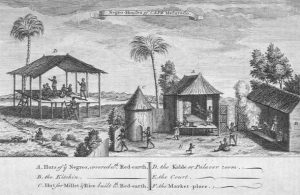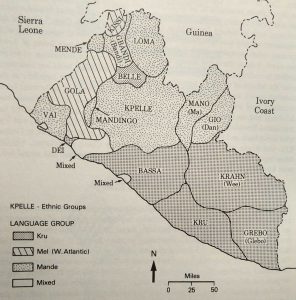The Grain Coast Natives
Origins and Classification of the Tribes

The indigenous tribes of the Grain Coast migrated to this land over numerous centuries from Abyssinia, the Sudan, Sahel and other eastern and northern African regions.
From their original lands and over their migration periods, the people of Africa developed and spread many innovations like metal works, farming, animal domestication, pottery, fishing and other skills.
Considerable regional travel into present day Liberia and Sierra Leone started in the eighth century when these areas were connected to the trading networks of the Sudan empire.
With varying and similar beliefs and customs, the tribes of Liberia occupied various sections of the land and formed an ethnic mix. Each tribe has a story about its origin and ancestors.
Native Liberians are divided into sixteen major tribes that are classified into three ethnolinguistic groups; namely the Kwa, Mel and Mende. More recent classifications refer to the Kwa as Kru and the Mel as Atlantic. All three groups are from the Niger-Congo language family; a category of over one thousand languages that are rooted from the Niger and Congo river basins, and spoken by millions of Africans.
| Kwa (Kru) | Mel (Atlantic) | Mende |
| Bassa, Belle, Dey, Grebo, Krahn, Kru | Gola, Kissi | Gbande, Gio, Kpelle, Lorma, Mandingo, Mano, Mende, Vai |
The Grain Coast

Credit: Wikipedia
Liberia is shown on ancient maps as a part of the Upper Guinea region on the Guinea Coast of Africa. European explorers and traders named the coastal promontories of Cape Mount, Cape Mesurado and Cape Palmas. This land was called the Pepper Coast, Grain Coast, Malagueta Coast or Winward Coast.
Prior to the 1800s, the Guinea Coast experienced a lot of trading and migration when trade routes were available to connect the various inland towns and coastal areas.
These movements were also influenced by conflicts in the ancient empires and European trading along the coast.
Migrations to the Grain Coast
Tribal migrations from the north and east to the West African Coast was over long periods of time. They consisted of small and large companies of people, and happened in numerous phases. Of the Liberian tribes, the Gola was the first migrant. They originated from Central Africa and moved westward to Mauritania before migrating southward to Guinea, Sierra Leone and Liberia. The Kissi arrived after the Gola and settled inland also, both tribes believed to have been in the region by 450 BC. They are classified as the Mel or Atlantic group.
Atlantic groups spread from a base in Mauritania, around 6,000 BC down the coast through Senegal and Gambia before entering Guinea, Sierra Leone and Liberia.
-Carl Patrick Burrows
The Kru tribes followed in a series of migrations. This included the Bassa, Belleh, Dei, Grebo, Krahn and Kru. They came west from the Ivory Coast, but had initially migrated from Western Sudan and North Africa as the medieval empires declined. Burrows suggests that the ancestors of the Kru broke from their Niger Congo root around 4000 BC and a group of their ancestors were in Liberia by 990 AD (Burrows, 2016).
Another wave of migration brought the Kpelle, Lorma, Gbande, Mende, Gio and Mano tribes. These tribes are mainly found in northern and western Liberia. The early settlements were concentrated mainly in the north, and most of the coast was uninhabited. Major migrations between the 1300s and 1700s moved many of these tribes to their more recent geographic locations. As more tribes migrated into the region, other tribes were pushed south towards the coast.

Credit: Liebenow
The Mandingo group comprising the Vai and Madingo came in the last migrations. The Vai came from the west in the sixteenth century and moved to the coast after defeating the Golas.
The Mandingo tribe arrived in the seventeenth century after migrating from the Sudan and later the Mali Empire. Unlike the other tribes, the Vai and Mandingo were Muslims.
These migrations were due to various reasons. Liebenow notes that the Gola migrated in search of salt, but other tribes were looking for fertile soil for agricultural purposes. Still, others were political refugees in search of stability. Population increase and trading also pushed people further away from the ancient kingdoms.
Colonialism and demarcation of Africa created national boundaries between some tribes, such that they are found in multiple countries, sometimes with different names. Representation in multiple countries also stemmed from migration where a company of the tribe migrated further or stayed behind. As a result, the Bassa, Dei, Grebo, Krahn and Kru are also in the Ivory Coast. Guinea has Gio, Kissi, Kpelle, Lorma, Mandingo and Mano; while Sierra Leone has tribes like the Gola, Mende, Kissi and Vai.
Intertribal Relationships and Powers
The tribes formed confederacies for trade benefits and political protection. There were also intertribal relations established through marriage, conquest, migration and slavery. Throughout these centuries various centers of powers and trade arose. These included the Dei and Vai regions in the 17th Century, the Mandingo area of Kondo in the 18th century, and Gola domination in the 19th century. Tribal towns or a conglomeration of towns were governed by native kings and elders.
Despite the profusion of languages, and the wide range of types of social organization, there is a high degree of cultural homogeneity and sectional traditions which often supersede local group solidarity and antedate the further integrative effect of colonial and national policy.
-Warren L. D’Azevedo
Sources
Burrowes, Patrick C. Between the Kola Forest and the salty Sea. Know Your Self Press. Liberia. Dec. 2016.
D’ Azevedo, Warren L. “A Tribal Reaction to Nationalism.” Liberian Studies Journal 1.2 (1969): 1–5. Print.
Green, John, and Thomas Astley. A New General Collection of Voyages and Travels : Consisting of the Most Esteemed Relations, Which Have Been Hitherto Published in Any Language, Comprehending Everything Remarkable in Its Kind, in Europe, Asia, Africa and America. London: Printed for T. Astley, 1747. Print.
Guannu, Joseph S. Liberian Civics. Monrovia: Herald Publishing, 2004. Print.
Kraaij, Van Der. The Grain Coast, Malaguetta Coast or Pepper Coast before 1822. Liberia Past and Present. Web.
Levitt, Jeremy I. The Evolution of Deadly Conflict in Liberia : From “Paternaltarianism” to State Collapse. Durham, N.C.: Carolina Academic Press, 2005. Print.
Liebenow, J. Liberia : the Quest for Democracy. Bloomington: Indiana University Press, 1987. Print.
Wilson, Charles Morrow. Liberia. W. Sloane Associates, 1947. Print.
Wulah, Teah. The Forgotten Liberian : History of Indigenous Tribes. Bloomington, Ind.: AuthorHouse, 2005. Print.
Visits: 506